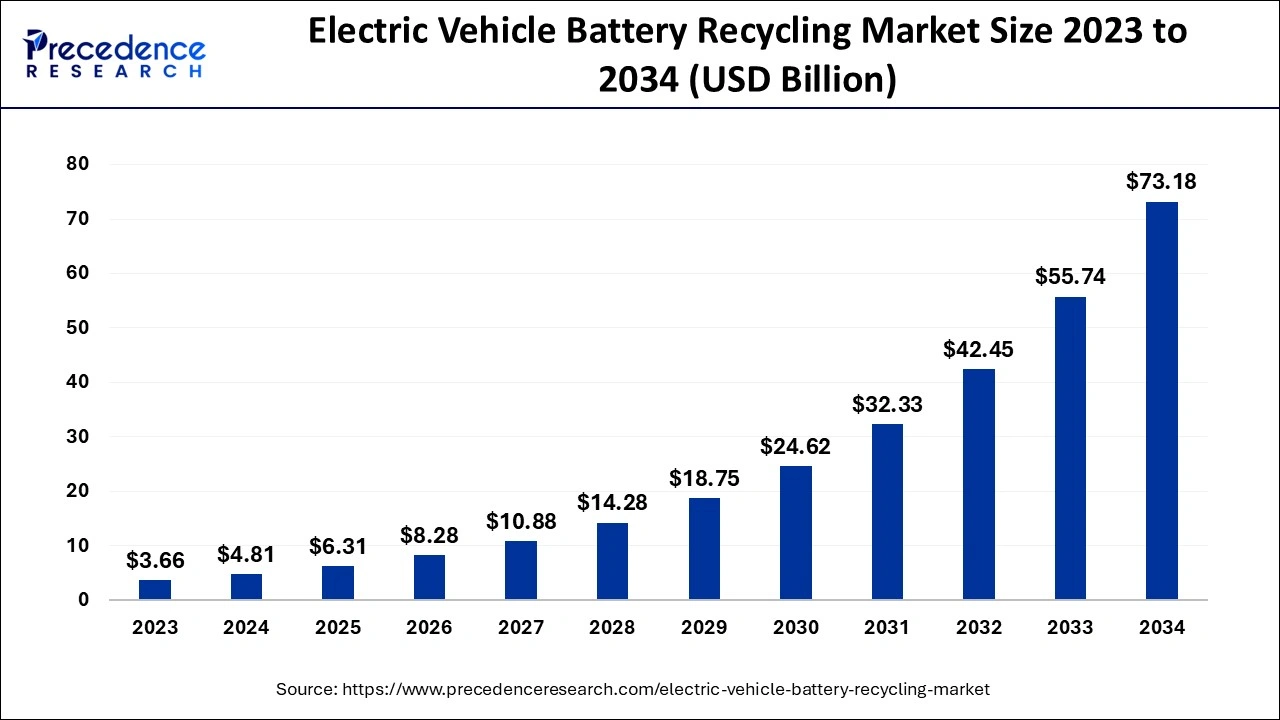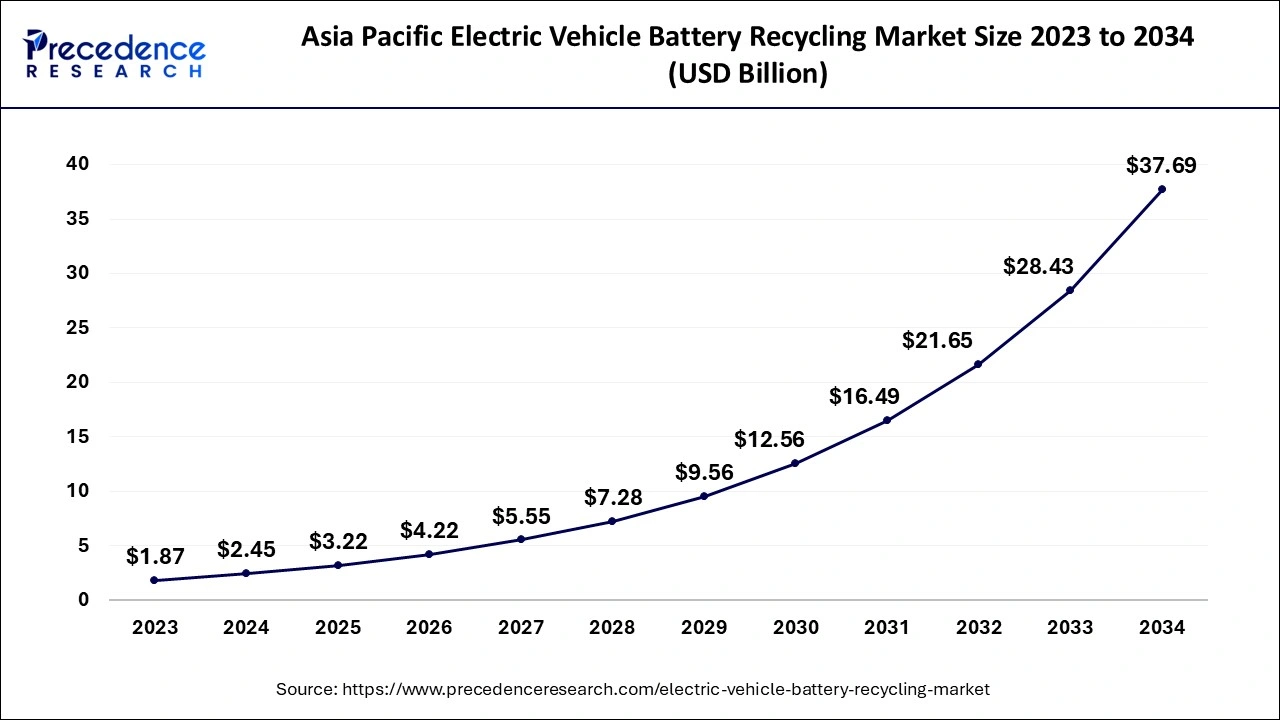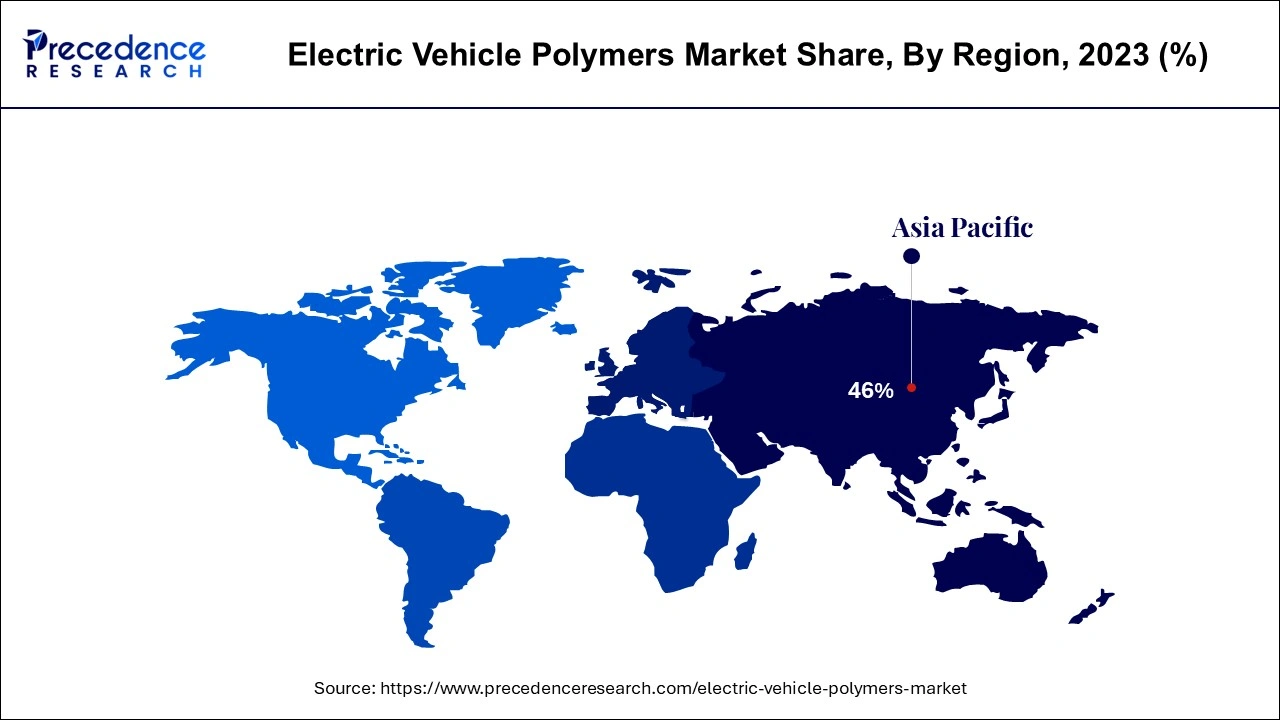April 2025
The global electric vehicle battery recycling market size accounted for USD 4.81 billion in 2024, grew to USD 6.31 billion in 2025 and is predicted to surpass around USD 73.18 billion by 2034, representing a healthy CAGR of 31.30% between 2024 and 2034.
The global electric vehicle battery recycling market size is estimated at USD 4.81 billion in 2024 and is anticipated to reach around USD 73.18 billion by 2034, expanding at a CAGR of 31.30% from 2024 to 2034.

The Asia Pacific electric vehicle battery recycling market size is evaluated at USD 2.45 billion in 2024 and is predicted to be worth around USD 37.69 billion by 2034, rising at a CAGR of 31.40% from 2024 to 2034.

In 2023, Europe region dominated the market with highest revenue share. The recycling rate of batteries is anticipated to increase as a result of the European Union's recycling efficiency standards. According to the regulations, about 75.0%, 65.0%, and 50% of the weight of battery must be recovered as recycled material for nickel-cadmium, lead-acid, and other chemistries, respectively.
In North America, used lead acid batteries are recycled at a rate of roughly 100%. Around 99.0% of the lead in used items gets recovered in the U.S. Additionally, it is anticipated that the presence of important recyclers such as Call2Recycle, Aqua Metals, Enersys, and Battery Solutions, Inc. will fuel demand during the forecast period along with the rising demand for UPS systems in commercial infrastructure and the rising popularity of electric vehicles.

Due to an increase in foreign investment, Central and South America is predicted to experience significant market expansion. For instance, the Cochrane Coal-fired Power Plant in Chile has a large lithium-ion battery storage system constructed by GS Yuasa Corporation in 2017. During the projected period, large-scale passenger and commercial vehicle manufacturing in Latin America is anticipated to fuel lithium battery demand.
Over the course of the projected period, Asia Pacific is anticipated to have the quickest CAGR of 8.5%. Due to the increasing demand from end-use sectors like the automobile, nations like China, India, and Japan are predicted to see rapid development.
The electric vehicle battery recycling market is made up of companies (organisations, single proprietorships, and partnerships) that sell electric vehicle battery recycling products and services used for recycling electric car batteries. Lithium-ion batteries are the most popular form of battery used in electric vehicles (EVs), and recycling these batteries allows for the recovery of important minerals such as lithium, manganese, cobalt, and nickel. These minerals are then utilised to manufacture fresh batteries. Mechanical and hydrometallurgical recycling technologies are used, and these battery treatment techniques have been developed for high safety, sustainability, and a high recovery rate.
Lead-acid batteries, lithium-ion batteries, and other types of electric vehicle batteries are the most often recycled. Lead-acid batteries are rechargeable batteries with a low energy-to-volume ratio and a high energy-to-weight ratio. They have a lower energy density, a long life, and are very inexpensive. The separation of lead metal from the batteries is a laborious procedure in the recycling of these batteries. For usage in commercial electric cars, advanced high-power lead-acid batteries are being developed. Pyrometallurgical, hydrometallurgical, and other procedures are employed in many vehicle types such as passenger automobiles and commercial vehicles. Electric automobiles, energy storage systems, electric buses, and other applications are among them.
Increased electric vehicle sales are likely to drive the growth of the electric vehicle battery recycling market in the coming years. Electric vehicles (EVs) are vehicles that are partially or entirely powered by electricity and feature a battery that drives an electric motor. electric vehicle batteries include important minerals that may be recovered by recycling end-of-life electric vehicle batteries and utilised to make new batteries for electric vehicles. For example, the International Energy Agency, a Paris-based autonomous international body, estimates that global sales of EVs, which comprise fully electric and plug-in hybrid vehicles, will reach 6.6 million units in 2021. In addition, the total number of EVs on the road worldwide in 2021 was 16.5 million. As a result, the growth in electric car sales is increasing demand for the electric vehicle battery recycling industry.
Factors such as rising demand for zero-emission vehicles, a tightening supply of certain battery pack components, and an increase in the use of recycled products are likely to boost the market for electric vehicle battery recycling. Furthermore, increasing uniformity in the legislative environment for electric vehicles in emerging nations would propel the electric vehicle battery recycling industry forward.
| Report Coverage | Details |
| Market Size in 2024 | USD 4.81 Billion |
| Market Size by 2034 | USD 73.18 Billion |
| Growth Rate from 2024 to 2034 | CAGR of 31.30% |
| Base Year | 2023 |
| Forecast Period | 2024 to 2034 |
| Segments Covered | Chemistry, Process, Application, End User, and Geography |
The lithium-based sub-segment is estimated to grow the quickest, generating $6.2 billion in sales by 2033. The lithium-based subsegment of the worldwide electric vehicle battery recycling market is growing due to factors such as good high-temperature performance, high power-to-weight ratio, and low self-discharge, all of which provide significant environmental benefits over other fossil fuel alternatives. With the increasing growth of electric cars, an immediate impact on carbon emissions reduction is envisaged. Such critical aspects might have a substantial influence on market growth throughout the forecast period. All of these reasons contribute to an increase in the demand for lithium ion automotive batteries.
The lead-acid battery sub-segment is forecasted to have a significant market share in the market and generate $3.7 billion in sales during the forecast period. Lead-acid batteries are regarded as a perfect source of power since they are heavy, cost-effective, and require little maintenance. The increased use of lead-acid batteries in a variety of applications, including backup power supplies, electric scooters, and maritime applications, as well as factors such as simplicity, price, and energy efficiency, are likely to fuel the expansion of this sub-segment. In the United States and Europe, more than 97% of lead-acid batteries are recycled, and around 75% of the lead used in new lead-acid batteries is generated from recycled batteries. All of these reasons contribute to the gradual increase in demand for lead-acid batteries.
The electric automobiles sub-segment is expected to expand the quickest, surpassing $5.6 billion by 2032 with a CAGR of 38.5%. Cars emit a large amount of carbon dioxide into the atmosphere, making people sensitive to pollution. An electric automobile is a significant step forward in terms of favourably assisting the environment. Electric vehicles have no exhaust emissions, making them greener, cleaner, and better for the environment than gasoline or diesel vehicles.
By Chemistry
By Process
By Application
By End User
By Geography
For inquiries regarding discounts, bulk purchases, or customization requests, please contact us at sales@precedenceresearch.com
No cookie-cutter, only authentic analysis – take the 1st step to become a Precedence Research client
April 2025
January 2025
January 2025
September 2024